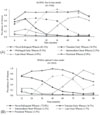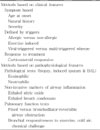Abstract
Asthma is a complex and heterogeneous disease, which is comprised of seperate phenotypes sharing common characteristics, such as airway inflammation, bronchial hyperresponsiveness and variable airflow limitation. Traditionally, asthma phenotypes have been described by combinations of clinical characteristics, according to the expert's recommendation, but they are now focusing on the pathobiologic mechanisms often using exploratory statistical methods. Several phenotypes and endotypes have been suggested by biased or unbiased phenotyping approaches. However, more detailed studies are still needed. In the future, more integrated large-scaled consortium of cohorts, including clinical information, genetics, molecular biology, and experiments will promote to understand the pathobiologic mechanisms of asthma phenotypes for the personalized therapy.
Figures and Tables
 | Fig. 1Schematic representation of the umbrella term 'asthma'. The key clinical features of severity (lung function, symptoms and exacerbations), inflammatory characteristics (particularly TH2 immunity) and their division into associated phenotypes are shown. However, these phenotypes have not yet been fully characterized (reprinted from Wenzel SE. Nat Med 2012;18:716- 25, with permission of Nature Publishing Group).2)
|
 | Fig. 2Estimated prevalence at each time point from birth to age 8 years for each wheezing phenotype (A) in Avon Longitudinal Study of Parents And Children (ALSPAC) free 6-class model (n=5,760), (B) in the Prevention and Incidence of Asthma and Mite Allergy (PIAMA) optimal 5-class model (n=2,810) (reprinted from Savenije OE, et al. J Allergy Clin Immunol 2011;127: 1505-12.e14., with permission of Elsevier).30)
|
 | Fig. 3 Overview of Mechanisms of the Development of ALLergy (MeDALL) (Bousquet J, et al. Allergy 2011;66:596-604, with permission of John Wiley & Sons).38)
|
Table 1
Asthma Phenotypes in Relation to Characteristics

IgE, immunoglobulin E; SBM, subepithelial basement membrane; IL, interleukin; FEV1, forced expiratory volume in 1 second.
Reprinted from Wenzel SE. Nat Med 2012;18:716-25, with permission of Nature Publishing Group.2)
Table 2
Methods of Classification of Asthma Phenotypes in Children

BAL, bronchoalveolar lavage.
Reprinted from Henderson J, et al. Arch Dis Child 2009; 94:333-6, with permission of BMJ Publishing Group Ltd & Royal College of Paediatrics and Child Health.15)
References
1. Hargreave FE, Nair P. The definition and diagnosis of asthma. Clin Exp Allergy. 2009. 39:1652–1658.

2. Wenzel SE. Asthma phenotypes: the evolution from clinical to molecular approaches. Nat Med. 2012. 18:716–725.

3. Moffatt MF, Gut IG, Demenais F, Strachan DP, Bouzigon E, Heath S, et al. A large-scale, consortium-based genomewide association study of asthma. N Engl J Med. 2010. 363:1211–1221.

4. Akhabir L, Sandford AJ. Genome-wide association studies for discovery of genes involved in asthma. Respirology. 2011. 16:396–406.

5. Rice JP, Saccone NL, Rasmussen E. Definition of the phenotype. Adv Genet. 2001. 42:69–76.
6. Anderson GP. Endotyping asthma: new insights into key pathogenic mechanisms in a complex, heterogeneous disease. Lancet. 2008. 372:1107–1119.

7. Lötvall J, Akdis CA, Bacharier LB, Bjermer L, Casale TB, Custovic A, et al. Asthma endotypes: a new approach to classification of disease entities within the asthma syndrome. J Allergy Clin Immunol. 2011. 127:355–360.

8. Bouzigon E, Corda E, Aschard H, Dizier MH, Boland A, Bousquet J, et al. Effect of 17q21 variants and smoking exposure in early-onset asthma. N Engl J Med. 2008. 359:1985–1994.

10. Soler M, Matz J, Townley R, Buhl R, O'Brien J, Fox H, et al. The anti-IgE antibody omalizumab reduces exacerbations and steroid requirement in allergic asthmatics. Eur Respir J. 2001. 18:254–261.

11. Busse W, Corren J, Lanier BQ, McAlary M, Fowler-Taylor A, Cioppa GD, et al. Omalizumab, anti-IgE recombinant humanized monoclonal antibody, for the treatment of severe allergic asthma. J Allergy Clin Immunol. 2001. 108:184–190.

12. Haldar P, Brightling CE, Hargadon B, Gupta S, Monteiro W, Sousa A, et al. Mepolizumab and exacerbations of refractory eosinophilic asthma. N Engl J Med. 2009. 360:973–984.

13. Nair P, Pizzichini MM, Kjarsgaard M, Inman MD, Efthimiadis A, Pizzichini E, et al. Mepolizumab for prednisone-dependent asthma with sputum eosinophilia. N Engl J Med. 2009. 360:985–993.

15. Henderson J, Granell R, Sterne J. The search for new asthma phenotypes. Arch Dis Child. 2009. 94:333–336.

16. Wenzel SE, Szefler SJ, Leung DY, Sloan SI, Rex MD, Martin RJ. Bronchoscopic evaluation of severe asthma. Persistent inflammation associated with high dose glucocorticoids. Am J Respir Crit Care Med. 1997. 156(3 Pt 1):737–743.
17. Miranda C, Busacker A, Balzar S, Trudeau J, Wenzel SE. Distinguishing severe asthma phenotypes: role of age at onset and eosinophilic inflammation. J Allergy Clin Immunol. 2004. 113:101–108.

18. Gibson PG, Simpson JL, Hankin R, Powell H, Henry RL. Relationship between induced sputum eosinophils and the clinical pattern of childhood asthma. Thorax. 2003. 58:116–121.

19. Martinez FD, Wright AL, Taussig LM, Holberg CJ, Halonen M, Morgan WJ. The Group Health Medical Associates. Asthma and wheezing in the first six years of life. N Engl J Med. 1995. 332:133–138.

20. Taussig LM, Wright AL, Holberg CJ, Halonen M, Morgan WJ, Martinez FD. Tucson Children's Respiratory Study: 1980 to present. J Allergy Clin Immunol. 2003. 111:661–675.

21. Martinez FD. The origins of asthma and chronic obstructive pulmonary disease in early life. Proc Am Thorac Soc. 2009. 6:272–277.

22. Moore WC, Meyers DA, Wenzel SE, Teague WG, Li H, Li X, et al. Identification of asthma phenotypes using cluster analysis in the Severe Asthma Research Program. Am J Respir Crit Care Med. 2010. 181:315–323.

23. Siroux V, Basagana X, Boudier A, Pin I, Garcia-Aymerich J, Vesin A, et al. Identifying adult asthma phenotypes using a clustering approach. Eur Respir J. 2011. 38:310–317.

24. Kauffmann F, Dizier MH. EGEA Co-operative Group. EGEA (Epidemiological study on the Genetics and Environment of Asthma, bronchial hyperresponsiveness and atopy)--design issues. Clin Exp Allergy. 1995. 25:Suppl 2. 19–22.

25. Siroux V, Boudier A, Bousquet J, Bresson JL, Cracowski JL, Ferran J, et al. Phenotypic determinants of uncontrolled asthma. J Allergy Clin Immunol. 2009. 124:681–687.e3.

26. European Community Respiratory Health Survey II Steering Committee. The European Community Respiratory Health Survey II. Eur Respir J. 2002. 20:1071–1079.
27. Fitzpatrick AM, Teague WG, Meyers DA, Peters SP, Li X, Li H, et al. Heterogeneity of severe asthma in childhood: confirmation by cluster analysis of children in the National Institutes of Health/National Heart, Lung, and Blood Institute Severe Asthma Research Program. J Allergy Clin Immunol. 2011. 127:382–389. e1–e13.

28. Woodruff PG, Modrek B, Choy DF, Jia G, Abbas AR, Ellwanger A, et al. T-helper type 2-driven inflammation defines major subphenotypes of asthma. Am J Respir Crit Care Med. 2009. 180:388–395.

29. Henderson J, Granell R, Heron J, Sherriff A, Simpson A, Woodcock A, et al. Associations of wheezing phenotypes in the first 6 years of life with atopy, lung function and airway responsiveness in mid-childhood. Thorax. 2008. 63:974–980.

30. Savenije OE, Granell R, Caudri D, Koppelman GH, Smit HA, Wijga A, et al. Comparison of childhood wheezing phenotypes in 2 birth cohorts: ALSPAC and PIAMA. J Allergy Clin Immunol. 2011. 127:1505–1512.e14.

31. Cho SH. Clinical characteristics and cluster analysis of elderly asthma. 2011. In : Symposia ll, 2011 Spring Congress of the Korean Academy of Asthma, Allergy and Clinical Immunology; 2011 Jun 3-4; Seoul. Seoul: Korean Academy of Asthma, Allergy and Clinical Immunology.
32. Kwon JW, Seo JH, Kim HY, Yu J, Hong SJ. Asthma phenotypes in school-aged children from the population study: cluster analysis. Proceedings of the 2012 AAAAI Annual Meeting. 2012. 2012 Mar 2-6; Orlando. Milwaukee, WI: American Academy of Allergy, Asthma & Immunology.

33. Holt PG, Sly PD. Interaction between adaptive and innate immune pathways in the pathogenesis of atopic asthma: operation of a lung/bone marrow axis. Chest. 2011. 139:1165–1171.

34. Thomson NC, Chaudhuri R. Asthma in smokers: challenges and opportunities. Curr Opin Pulm Med. 2009. 15:39–45.

35. van den Berge M, Heijink HI, van Oosterhout AJ, Postma DS. The role of female sex hormones in the development and severity of allergic and non-allergic asthma. Clin Exp Allergy. 2009. 39:1477–1481.

36. Singh AM, Moore PE, Gern JE, Lemanske RF Jr, Hartert TV. Bronchiolitis to asthma: a review and call for studies of gene-virus interactions in asthma causation. Am J Respir Crit Care Med. 2007. 175:108–119.
37. Bel EH, Sousa A, Fleming L, Bush A, Chung KF, Versnel J, et al. Diagnosis and definition of severe refractory asthma: an international consensus statement from the Innovative Medicine Initiative (IMI). Thorax. 2011. 66:910–917.

38. Bousquet J, Anto J, Auffray C, Akdis M, Cambon-Thomsen A, Keil T, et al. MeDALL (Mechanisms of the Development of ALLergy): an integrated approach from phenotypes to systems medicine. Allergy. 2011. 66:596–604.

39. Hong SJ. Childhood asthma and allergic diseases cohort study. Public Health Wkly Rep. 2010. 43:721–726.
40. Kim HB, Seo JH, Kim HY, Kwon JW, Kim BJ, Hong SJ. The association of cord blood immune markers with atopic dermatitis in infant aged 6 month old. Korean J Asthma Allergy Clin Immunol. 2011. 31:2 Suppl. S155.




 PDF
PDF ePub
ePub Citation
Citation Print
Print


 XML Download
XML Download